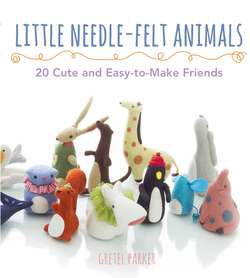Читать книгу Little Needle-felt Animals - Gretel Parker - Страница 14
ОглавлениеGetting Started
Needle-felting is so simple – simply grab some wool, your felting mat and a couple of needles (see here) and get stabbing! A few basic techniques are useful to know about before you begin, though, so read on.
How Does Needle-Felting Work?
Wool fibres are covered in small scales and natural oil. The action of continually pushing sharp, barbed needles into it makes it matt together – or ‘felt’. The more the wool is worked, the firmer it becomes. As the air is punched out and the fibres stick together, the volume of the wool decreases dramatically. So although it seems as if you’re starting out with a large amount of material, the finished piece will be about a third of the size of the original mass.
Don’t worry if you make mistakes; they are easily fixed. You can even cut bits off and patch it over as if nothing had happened. Wool is a wonderful, versatile material.
Tear, Don’t Cut
Try to tear your wool apart, rather than cutting. Rough ends meld together far better than cut ones.
Measuring and Sizes
Follow the pattern measurements and finished project sizes as closely as possible. However, the measurements are approximations only, so don’t panic if something comes out a centimetre shorter or taller.
Stabbing
There is really only one technique to needle-felting – gently stabbing the wool with one or two needles until it firms up. At first it feels as if you are jabbing at thin air, but after a few minutes you begin to feel some bite. A while later you will hear a quiet scrunching sound, as if you were walking through snow. When you hear this, you know that the wool is getting to the malleable stage, when you can start to shape and sculpt it.
Folding Over
Many of the patterns in this book start in the same way: folding wool over and inserting various sizes of filling. This bulks out the bottom of the animal or bird, making a basic bulb or teardrop shape, which is then developed as the pattern progresses.
Shaping
Your fingers are the other tool you need for successful shaping. To make thin forms, pinch together the roving as you carefully work with one needle, to fix and solidify the wool. It takes time, but even the skinniest of tails can eventually be made firm.
Flat Bottoms
Several of the designs need a nice flat bottom to sit on. If you hold the body vertically on the felting mat, so that it is already ‘sitting’, you will get a preliminary flat base, which you can then pick up and work on. Using your thumb and index finger as a circular template helps define a neatly curved edge.
Turning Work
Unless you actually want a flat design, turn your project as you work so that you are treating all sides equally. It’s quite tempting sometimes to get so involved with one area that the rest is forgotten, which results in overworked areas. A project is never entirely finished until the final stage, when the fine-tuning takes place. For me, this is the part that takes the most time.
Patching and Tidying
There will be times (such as when you have added elements) when there is a visible join. This is where wool shines as a medium. Simply use tiny tufts of wool to fill in any gaps and then cover over the filled join with a thin layer of wool. Work carefully and neatly, and the added wool will blend in, making your work appear seamless.
Layering and Finishing Off
1 The final finish of any piece of work is so important. If, like me, you want as neat and smooth a surface as possible, then be prepared to put the time in. Use very thin veils of wool, teased out so finely that you can see through them.
2 Carefully cover your work with this thin veil of wool, using two 40 or 42 needles. Work closely and with regular movements, not jabbing too hard. The wool fibres should follow the length of the body and lie in the same direction as much as possible.
3 Look carefully at the surface; it will look like orange peel. Using one needle, poke the tiny dimples down. When you’ve done this all over, go back and do it again and again, until you are satisfied.
Fuzzies
Fuzzies are inevitable. Merino wool is especially hairy. Layering and careful needling means that you will get a finer finish, but there is no shame in trimming your work. I shear mine by holding scissor blades flat across the surface, but do be careful that you don’t damage your work when you do this.
Use Your Judgement
No matter how closely you follow a pattern, needle-felting is mostly a matter of judgement. How does the felted wool feel in your hands? Is it too loose, too hard, or just right? If it’s too hard, it will be difficult to add extra parts. If it’s too soft, it is not so easy to sculpt. As you do more and more needle-felting, however, judging the wool will become second nature – rather like sensing the right tension in knitting.
Take Your Time
Getting a fine finish can take some time, so if you want to make something quick, start with a small pattern, such as the Happy Hedgehog or Chunky Funky Snail. Needle-felting is not a craft to be hurried, and many people find the gentle pace very therapeutic.
And Finally...
Don’t worry if your animal doesn’t turn out exactly as the one in the photograph. The wonderful thing about needle-felting is that it is such an expressive craft; that each person brings their own touch, and no two styles are the same. There are no strict rules. Follow the patterns, try the techniques, but most important, have fun!
